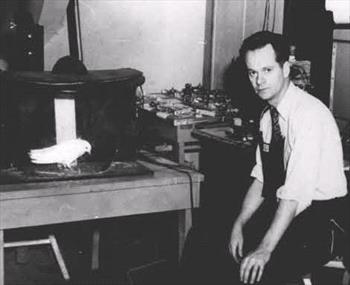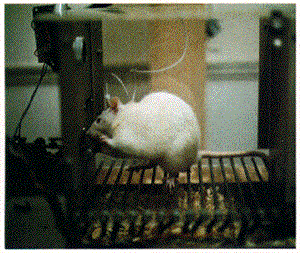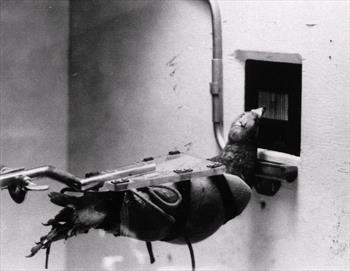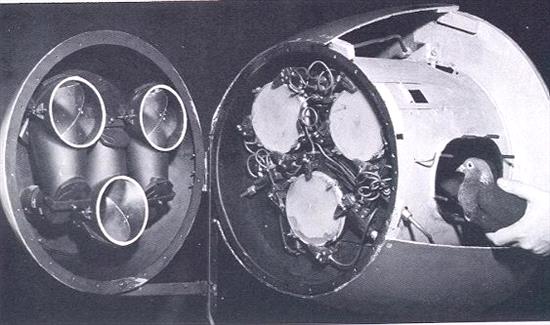
Virtually everyone who trains animals knows the name B.F. Skinner. Burrhus Frederic Skinner (1904–1980) is one of the best-known psychologists in history. His claim to fame is the Skinner Box—a more-refined version of Thorndike’s puzzle box. The box had a lever, a slot for food rewards, and water. The rat could explore and if it happened to press the bar a food pellet would drop into the tray. The cage was wired to automatically record behavior showing the cumulative number of presses per minute.
Similar boxes were made for pigeons. Due to this efficient way for testing rats and pigeons and collecting data, Skinner was able to perform many studies on learning in rapid succession. He studied many aspects of learning, including: which types of reinforcement rates lead to the fastest learning and the strongest behavior, how learning extinguishes when reinforcers are discontinued, and the effects of intermittent reinforcers on extinction. From this data, he formulated a number of principles that shed light on the behavior of rats, pigeons and ultimately, humans. This was the birth of operant conditioning.
While Thorndike’s instrumental conditioning stated that the consequence of a behavior determined whether the behavior is strengthened or weakened, operant conditioning built upon this by recognizing that any random movement the animal makes can be thought of as operating on the environment and can be rewarded. By rewarding movements that are incrementally closer to a goal behavior, one could train a behavior that’s very different from the original behavior or even from the animal’s natural repertoire of behaviors.
Today, Skinner’s principles that desired behaviors should be reinforced, that behaviors can be built in incremental steps, and that immediate reinforcement generally provides a better learning than delayed reinforcement has been used extensively in training, not only with animals but humans too. It has revolutionized how textbooks and grade school teaching programs have been designed and programs for people with mental and emotional disorders. One reason for the widespread use of such techniques is that Skinner was a showman who popularized the science to the public. For instance, he taught pigeons to play Ping-Pong or peck a tune on a piano for television shows.
Skinner’s operant conditioning research advanced quickly and, after only 8 years, made its way out of the research lab and into an applied setting. During World War II, in an effort to aid military operations, Skinner developed a project called Project Pigeon, which set out to train pigeons to guide missiles by pecking at an image of the target site on a screen. Skinner took six pigeons to Washington D.C. with the apparatus in which they were trained, which for all intents and purposes would be the same as a nose cone for a guided bomb.The demonstration was successful. Three pigeons at a time worked in the cone as a fail-safe situation in case one or two got sick. While none of the birds failed, the Navy turned down the project for, probably, a number of reasons. One of Skinner’s graduate students at the time, Marian Breland-Bailey was there. She recalls, “The Admirals looked inside at the guidance system and saw the three pigeons pecking away. This caused them several minutes of disbelief. “ Marian also points out that the Admirals knew that the atomic bomb was on it’s way and that there would be no need for pin-point missiles.
Despite this setback, something positive came out of the experience, two of Skinner’s graduate students, Marian and Keller Breland, had helped with the system and had learned far more from working on this project than they had learned in class. They became skilled at shaping—a process by which you start by rewarding a behavior you can get and systematically reinforcing behaviors that are closer and closer to the goal behavior. They also learned about secondary reinforcers, where they used a unique tone such as a clicker or whistle, paired it many times with food and then could use the sound to tell an animal exactly when it had done something right and that a food reward was coming.
“We realized then how powerful the techniques were and decided right then and there, as soon as we could after the war, we’d get into some kind of business that used these techniques,” says Marian. “We decided that we weren’t quite ready to tackle human problems and we realized we weren’t going to go on to finish our PhDs, so we began to think of animals.” Their goal was to share this new, humane way of training with the world.





